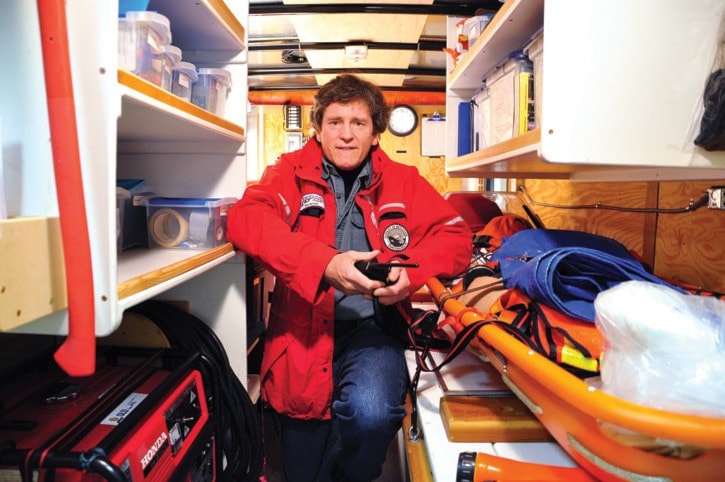Responsibility, coverage area grows for Metchosin search and rescue
It’s 2 a.m. and raining when Craig Barlow is awoken by his phone. It could be a lost hiker on Mount Finlayson, a senior citizen that wandered away from a care home, or someone who has vanished.
In any event, he has 40 minutes to collect his wits and arrive at the incident scene. Time is of the essence when seeking someone likely disoriented, scared and exposed to the elements.
Barlow is the group leader and search manager for Metchosin Search and Rescue, a 30-person volunteer group that started small in 1989 in partnership with Pearson College.
Two decades later, and as various SAR teams have disbanded, the Metchosin squad has inherited search and rescue responsibilities across the West Shore, Victoria, Oak Bay and Esquimalt.
“It was only Metchosin in the early days, but the area of responsibility has slowly grown,” says Barlow, a 21-year veteran of SAR. “We’re Metchosin Search and Rescue in name only now. Even some of the police don’t know and wonder why Metchosin is called out.”
With greater responsibility comes more searches. Until a few years ago, Metchosin SAR attended about four incidents per year, typically lost hikers or persons intent on taking their own life. In 2010 callouts were up to 14.
The volume isn’t expected to ease. Metchosin SAR group had two incidents in January this year, mutual aid callouts — one on China Beach for a missing male and the second in Duncan for Tyeshia Jones, an 18-year-old who was found murdered.
Metchosin SAR was also involved in the evidence search in two Langford locations after the murder of Kimberly Proctor last March. All SAR calls are treated equally, Barlow says, but it’s difficult to keep emotions in check when incidents involve young people or children.
“I like to think it’s the same level of effort regardless, but the reality is it’s not true. There is a heightened level of awareness,” Barlow says. “When people join the group the likelihood is real they may be required to work a murder or a suicide, there is a high likelihood they’ll find a deceased victim.”
Urban searches are becoming more common, especially for people suffering from dementia or Alzheimer’s, but not always. Last year they searched for a young suicidal teen who was found somewhere between Fairfield and her mom’s home in James Bay.
More typical though, is a search for hikers lost in the woods, often due to starting their hike too late in the day with poor clothing and few provisions. In the summer of 2009 Metchosin SAR found a young woman at the top of Mount Finlayson at midnight. Too dangerous to hike down, the team kept her warm and safe until dawn.
“She was dressed in shorts and running shoes,” Barlow says. The lost girl called 9-1-1 on her cellphone, a technology which makes SAR easier but also engenders bad habits.
“Having voice contact makes searching easier. On the flip side, (cellphones) make people cavalier about how they approach hiking. Most people are very poorly prepared, without enough food or water, and clothing that’s too light.”
“Most people have no awareness of the level of search they’ve mobilized,” adds David Richardson, a Metchosin SAR volunteer for two years. “Many lost hikers don’t realize 15 people have been up all night in the rain.”
Urban or wooded, the search radius depends on the length of time a person is missing. More than 12 hours and the search grid becomes “the rest of the world.” But SAR members aren’t methodical to a fault — they check the logical spots first, such as nearby trails.
“Most people walk in circles for hours and get more lost. What they should do is stop and stay still,” Barlow says.
“But when you find someone it’s gratifying beyond belief. It’s disheartening when you find nothing. It’s frustrating not being able to provide closure to a family.”
Despite covering a large piece of the Capital Region, most Metchosin SAR members are from the Metchosin area. They tend to be backcountry oriented and “safety conscious adventurers,” Richardson says.
Indeed, the final phase of ground SAR certification is about gaining empathy with someone who is lost in the forest. Being an outdoor type helps.
“During training the last thing you do is spend the night in the woods,” Richardson says. “No tent, no sleeping bag.”
editor@goldstreamgazette.com
